It has been said that rendering aid during a mass casualty incident (MCI) is trying to create order out of chaos. When most people hear the term “mass casualty incident,” it conjures up images of major catastrophic events: hurricanes, terrorist attacks, plane crashes, etc. Those are all prime examples to be sure, but an MCI can happen anytime and anywhere. Simply put, an MCI is any scenario in which those needing aid outnumber those able to provide it. In these scenarios, the SALT triage technique is a powerful tool.
The occurrences of MCIs are few and far between. But sadly, not as few and not as far between as one might think. They can be naturally occurring or man-made, accidental or intentional. Natural disasters, hostile events, civil unrest, even multi-passenger vehicle accidents — to name a few — happen all around us at an alarming rate. Imagine you’re near, or even involved in an MCI, but are fortunate enough to be minimally injured or completely unharmed. In many situations, first responders are immediately on their way. In others, emergency response resources are far away or overwhelmed and help could be hours or even days away.

Above: Mass casualty events aren’t just shootings or terrorist attacks. They’re often accidental — for example, vehicle crashes involving multiple pedestrians.
There are a few options at that point: You could determine the catastrophe is the responsibility of those who are trained to provide aid and stand aside, or you could do whatever you can, regardless of training, to provide assistance. Obviously, performing advanced medical procedures outside of your scope of training is a bad idea, but there are many things you can do as a bystander that could immensely help a situation. In those scenarios, Good Samaritan laws provide cover for those acting in good faith and not gross negligence.
DISCLAIMER
This is a general overview and not a comprehensive guide to triage or trauma care. Whenever possible, call paramedics and defer to their expertise once they arrive.
What You Can Do
First things first — always perform within the scope of your training. Despite what you see in the movies, using a knife and a straw to perform an emergency tracheotomy, for the vast majority of us, is a really bad idea. Likewise, employing a makeshift electrical cord defibrillator or stabbing someone in the heart with anything, Pulp Fiction style, should be avoided in every circumstance. That said, even though the majority of the general public has little to no formal medical instruction, there’s still a lot of good that can be done.
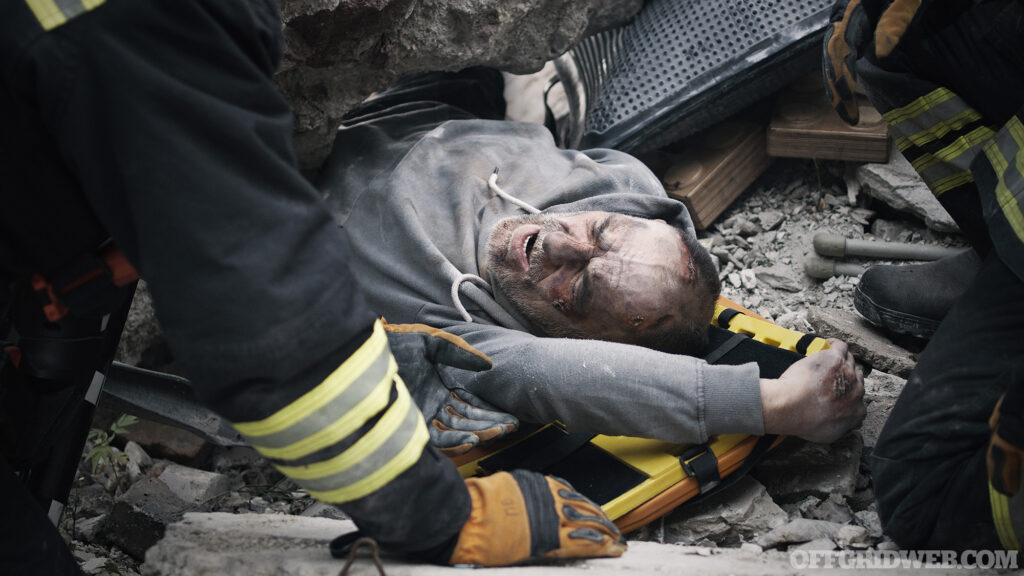
Above: Natural disasters such as earthquakes and tornadoes are another common source of mass casualty incidents.
For the sake of this article, let us assume you have no medical training or certifications that would allow you to perform any procedures beyond fundamental first aid. Being a first responder for the past 25 years, I can tell you there are basic skills and actions the general public, without medical credentials, are able to perform which can have a great impact on the overall outcome of an MCI. The overarching goal will be to help as many people as possible by spreading and utilizing the available resources as efficiently as possible. Sometimes, the available resource is simply you.
Location
There are many factors when it comes to sorting patients. While you may not know the exact number involved, you can make rough estimates. Did this incident happen at a crowded shopping mall or at a bus stop? The reason it matters is because you’ll need to identify a safe location to evaluate injuries. It’s imperative that you have the safest possible place to corral them. The ideal location is uphill and upwind of the incident that’s safe, secure, and allows easy ingress and egress for transporting units. It isn’t often, though, that an ideal location is available. Choose the closest safe location that you can find.
Treatment and Transport Location Considerations:
- Physical location: safely away/close enough to be practical
- Protected from ongoing/additional danger
- Access and egress
- Structural hazards
- Weather exposure
- Wind direction
- Time of day/lighting
- Hazardous materials runoff
- Access to first aid supplies if available
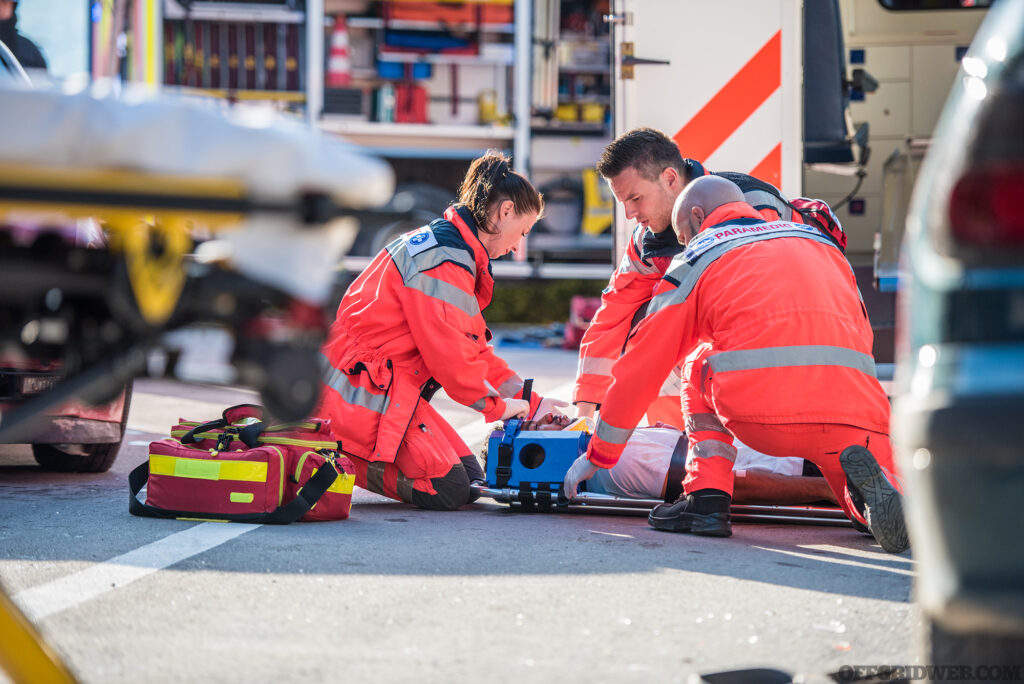
Above: Professional first responders can’t be everywhere at once. As a prepared individual, you should be ready to render aid and stabilize patients until the cavalry arrives.
Personal Protective Equipment
Stating that one shouldn’t render first aid without full personal protective equipment, although accurate, would be impossible in most mass casualty scenarios. Those who carry first aid kits on their person, in their packs, or in their vehicles will be better prepared than most to protect themselves from blood-borne pathogens, airborne contaminants, and environmental factors like the weather and the harsh incident environment. The unpredictability of an MCI pretty much assures us that we won’t have all the needed PPE supplies with us in the moment. The take-home message: Do the best you can to protect yourself and others when providing aid.
Minimal Recommended PPE:
- Work gloves or nitrile medical gloves
- Safety glasses
- Surgical mask or respirator
- Hearing protection (for loud environments)
- Weather and environment appropriate clothing
Triage
As previously mentioned, doing the greatest good for the greatest number of people is the objective in a mass casualty scenario. One of the most effective ways to do that is to determine who has immediate medical needs versus those whose injuries aren’t life threatening and therefore treatment can be delayed. Triage is a French word meaning “to sort.” Origins of triage date back centuries but the modern practice is believed to have been traced back to Napoleon’s army. In any scenario where the number of patients outnumbers those who are there to provide aid, they must be “sorted” by order of medical priority.
Sorting patients can be a fluid and somewhat subjective experience, particularly without the aid of medical equipment to make any specific and verifiable diagnosis. The fluidity of triage lies in the fact that it’s ongoing. It’s not a one-time occurrence. The environment can improve, adjust, or deteriorate, sometimes drastically. The same can be said for the condition of a patient, which is why a consistent cycle of triage and re-triage is important. It begins with the initial division of those affected.
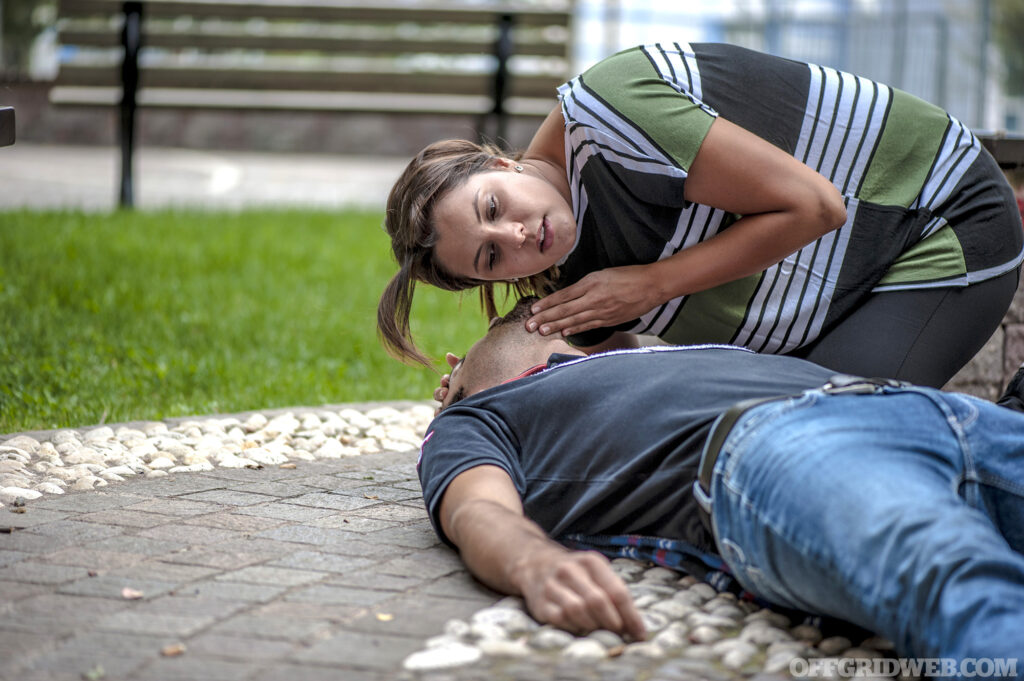
Above: Individuals who are breathing but not moving are categorized as “Red” and should be assessed first.
SALT Triage
There are a variety of ways to divide patients by medical priority. One of the most widely adopted methods to quickly determine the potential severity of injuries to patients and triage them into prioritized categories is to use SALT Triage. Sort, Assess, Lifesaving interventions, and Treatment and/or Transport give us the acronym: SALT. This method was developed in 2006 by a Center for Disease Control (CDC) workgroup made up of the National Association of EMS Physicians (NAEMSP) and has been proposed as the national standard for mass casualty triage. SALT is scalable — it can be used in a catastrophic MCI or when it’s simply you with two patients.
SALT outlines a common-sense approach to managing a mass casualty incident by presenting simple yes or no questions, allowing you to rapidly determine who potentially has the greatest medical needs and should receive priority treatment. The term “potentially” is used because, although SALT is widely adopted, it’s less an advanced medical process and more of a down-and-dirty, in-the-field, best-educated guess.
It should be noted that SALT Triage is a diagnostic tool for use with adult patients only. In an MCI, you may have to apply some judgment when determining if a patient is considered an adult or child. As a basic rule, if the patient is big enough to be or looks like an adult, treat them as an adult.
Sort
The first step in SALT Triage is to sort patients into manageable groups by dividing them into four categories: Those who can walk, those who cannot walk but can make purposeful movement and follow simple commands, those who are breathing but not moving, and those who aren’t breathing. Patients are divided into four colored categories:
- Green: walking wounded. Assess third.
- Yellow: injured but with purposeful movement. Assess second.
- Red: breathing but not moving/still. Assess first.
- Black: not breathing and/or with injuries consistent with obvious death. Deceased. Leave in place.
To begin, shout something like, “If you can walk, come over here!” Direct those people to a safe location to await treatment and transport. Those people will still require evaluation but are third on your priority list. In fact, in many cases, your greens, or the “walking wounded,” can be used to help you sort and treat your reds and yellows. Put them to work.
Next, ask anyone who is hurt, but cannot walk to follow a simple command. “Raise your hand if you are hurt but cannot move.” Those who respond will be your “yellows” and, if safe to do so, should be left in place for the moment. You and those who are available to help you, should immediately address those who aren’t responsive. They’re likely critically injured or deceased. There will be exceptions to these rules, but this is a time-critical process of numbers. It’s going to consist of making assumptions and educated guesses.

Above: If a patient isn’t breathing after you’ve adjusted their airway, you’ll have to move on to the next patient. There’s no time for CPR in a mass casualty event.
Assess – Red: The patients you deem should be assessed first.
Are they breathing? If not, you should adjust the airway. If there are still no respirations, they’re deceased. There’s no time for CPR in a mass casualty incident. Do they obey commands? Do they have a peripheral pulse? Are they breathing normally? Can their bleeding be simply managed? If the answer is no to any of these questions, they’re a “red” priority patient and quick lifesaving interventions should be performed. The assessment of a red patient is somewhat basic: adjust the airway if they aren’t breathing or struggling to breathe, control major bleeding, and have them transported as quickly as possible. The sorting, assessment, and interventions should take no more than 1 minute per patient.
Lifesaving Interventions:
- Adjust airway (head tilt/chin lift)
- Control major bleeding (tourniquet/pressure points)
Treatment and/or Transport:
Move immediately to a treatment area for treatment and expedited transport.
Assess – Yellow: The patients you deem to be assessed second.
What are the extent of their injuries? A yellow patient can simply be anyone in between the walking wounded and critical. If your confidence and comfort level allow, there are some basic assessments you can execute in order to better evaluate the status of the patient. In this series of rapid assessments, patients can be re-triaged as red or green. There are three areas to evaluate:
- Mental Status: A quick way to determine the mental status of a patient is the AVPU scale. The AVPU acronym stands for alert, verbal, painful, unresponsive. This evaluation indicates if a patient is awake and can follow commands (alert), they respond to verbal stimulus but aren’t able to answer simple questions or follow commands (verbal), they respond to painful stimulus such as a sternal rub (painful), or are altogether unresponsive. Any patient who falls under V, P, or U should be re-triaged as red.
- Respirations: If patient respirations are over 30 per minute, they should be re-triaged as red.
- Perfusion: Press the fingernail bed of the patient (if there’s no nail polish present). The pressure will cause the nail bed to turn white and should return to pink in less than 2 seconds after your release. This is a measure of capillary refill. If color does not return in under 2 seconds, there could be an internal perfusion issue and they should be re-triaged red.

Above: Pressing and releasing a patient’s fingernail can help you gauge capillary refill. If color remains white for more than 2 seconds, there may be a circulatory problem.
Lifesaving Interventions:
Not needed for yellow patients. Care of the “yellow” patients will occur once the critical patients have been addressed. Yellow treatment will occur in place, or preferably, in a designated treatment area.
Treatment and/or Transport:
Move, when possible, to the treatment area for transport after priority patients (reds) are off the scene and en route to advanced care.
Tagging Patients
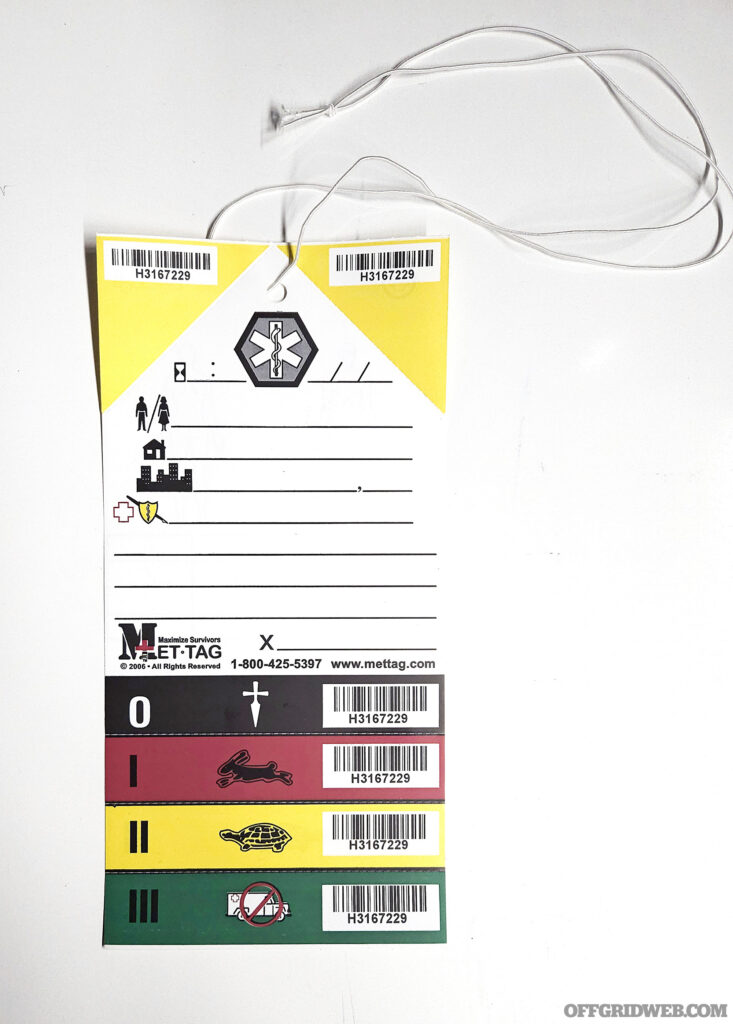
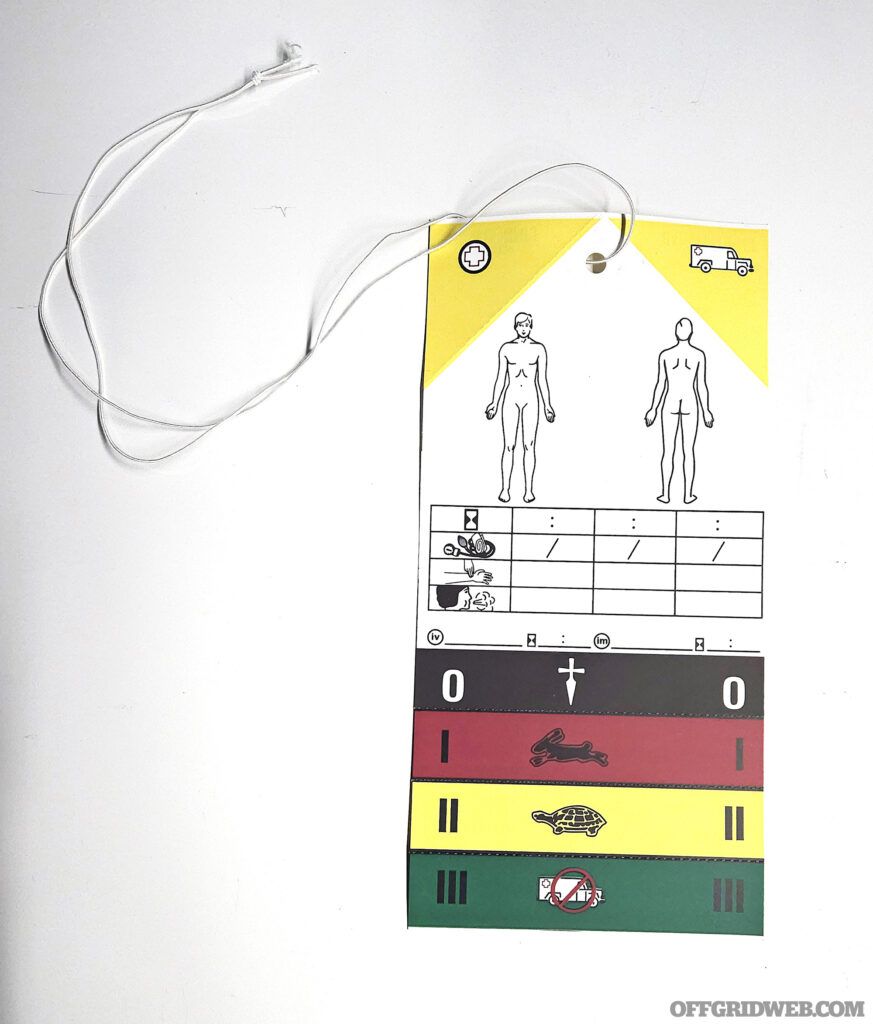
This is an example of a triage accountability tag used by first responders after quickly performing a SALT Triage and determining the triage “color” of the patient.
Documentation
Without question, documentation will be the lowest priority and last step of any type of MCI. It is, however, an important one. If resources allow, it’d be greatly beneficial to first responders, family members of those involved, and post-incident investigators to designate a scribe. Patient names, descriptions, extent of injuries, location they were found, and where they were transported to are all meaningful pieces of information. The likelihood of getting all necessary information is minimal, but anything you can document would be far more reliable than your memory after a major stressful event.
It could be something as simple as: Hispanic male, 40s, blue jeans, and long-sleeve white shirt. Found unresponsive near the south door. Relocated to treatment center. Unknown transport destination. Before the incident winds down, you can be sure family members are going to be desperate for information regarding their loved ones.
Summary
There isn’t much that can prepare you for the impact of experiencing firsthand injury and death on a mass scale. You can expect an MCI to be both chaotic and emotional. There will be thoughts, feelings, and reactions that you may not expect or be prepared for. First responders are trained and equipped to manage a crisis — you may or may not be. What you can do, though, is be diligent in your readiness and, when the tragic situation presents itself and you can do some good, do good for as many as you can. Lives may depend on it.
Read More
Subscribe to Recoil Offgrid's free newsletter for more content like this.
Editor's Note: This article has been modified from its original version for the web.
The post SALT: Learn The SALT Triage Method appeared first on RECOIL OFFGRID.
https://www.offgridweb.com/survival/salt-learn-the-salt-triage-method/
 CampingSurvivalistHuntingFishingExploringHikingPrivacy PolicyTerms And Conditions
CampingSurvivalistHuntingFishingExploringHikingPrivacy PolicyTerms And Conditions
